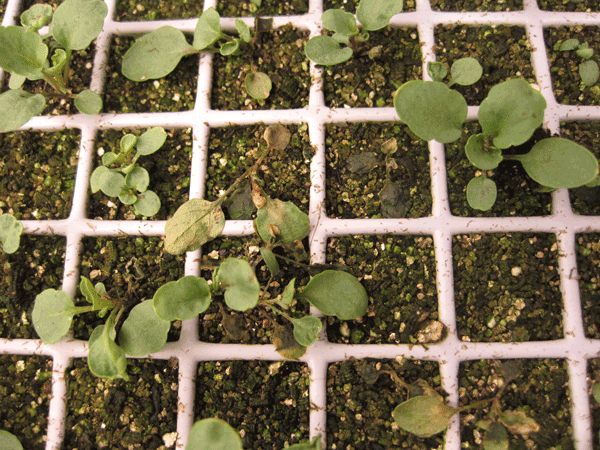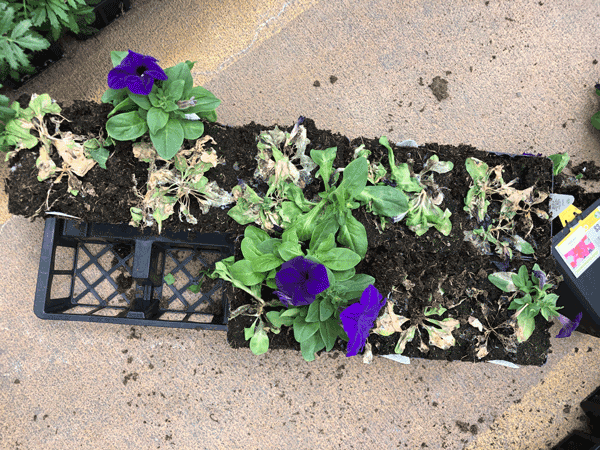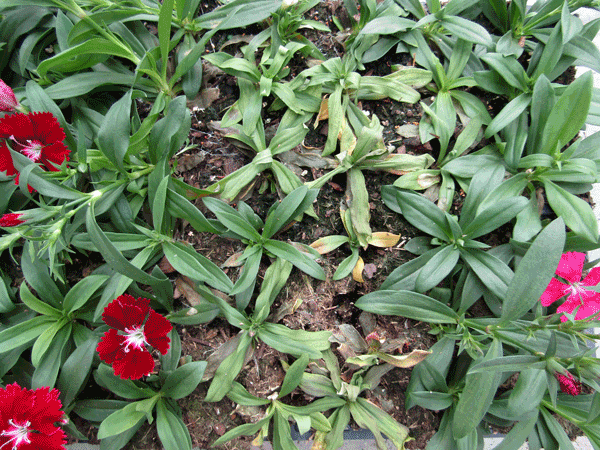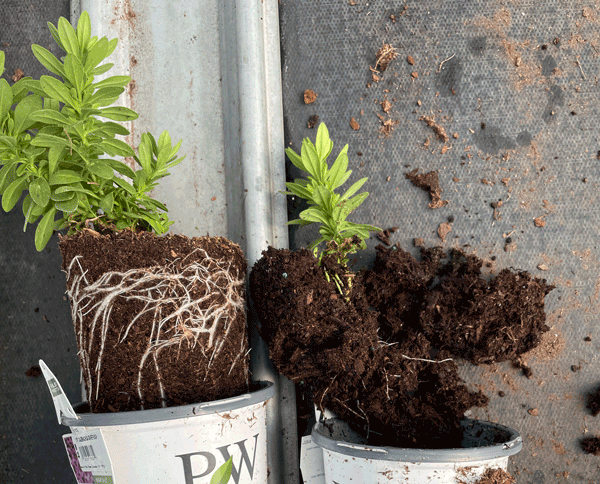Introduction
Many species of annual and herbaceous perennial ornamental and vegetable plants produced in the greenhouse are susceptible to soilborne diseases. Symptoms of soilborne diseases often include pre- or post-emergence damping-off, wilting, chlorosis (yellowing), loss of plant vigor, and root or crown rot. Many soilborne pathogens and plant-parasitic nematodes can reside in infested soil or soilless media, crop debris, on pots and trays; or on equipment for long periods of time. Species in the following genera (and the diseases they can cause) may be encountered in greenhouse crop production: Phytophthora (Phytophthora root and crown rot, aerial blight), Pythium (damping off [Figure 1], Pythium root rot), Rhizoctonia (damping off and stem rot), Fusarium (Fusarium root and crown rot, Fusarium wilt [Figure 2]), Berkeleyomyces (black root rot [Figure 3]), Ralstonia (bacterial wilt), Sclerotinia (white mold [Figure 4]), Athelia (southern blight [Figure 5]), and plant parasitic nematodes. Many of these pathogens have a broad host range and may survive on weed hosts. Losses caused by soilborne diseases can be significant, and prevention is the most practical means of management.
This publication details strategies for preventing and managing soilborne diseases in greenhouse crop production using soilless media. These tactics include sanitation measures, cultural practices, and the application of treatments to limit the development and spread of these diseases in the greenhouse.
For more information regarding greenhouse operations, or for any questions that you may have regarding the management of plant diseases, contact your local horticultural extension agent. In addition, factsheets are available online that provide more detail on diagnosis and management of many of these diseases in ornamental crops and vegetable crops.
Sanitation
Proper sanitation practices are critical to the prevention of disease. Following the guidelines below can help to ensure that soilborne pathogens are not introduced to or spread within a greenhouse production system. Due to the variability in crop production practices in greenhouses, these guidelines may not be comprehensive and additional measures may be required, depending on the plants grown, diseases present, and your production system.
Sanitize production area. Used soil or media should be removed from production areas including under benches and on walkways. Equipment, benchtops, tools, and containers should be kept clean and free of old or used potting media or plant debris. To allow for complete sanitation of surfaces, equipment and benchtops should be washed with water to eliminate residual soil or organic material before using a sanitizer. Watering wand heads should never come into contact with the floor or soil because they can pick up and subsequently spread pathogens among the crop. Tools should be washed thoroughly to remove media, plant material, sap, or films before sanitation.
Use clean media. Only potting mix or soilless mix that has been treated or is certified to be free of pathogens should be purchased. Avoid re-using potting media or using raw soil as these sources can harbor plant pathogens. Fresh potting media should be handled carefully to avoid the introduction of unwanted organisms. This means storing it on a clean surface and moving it with clean equipment. New potting media should not come into contact with used potting media, used tools or equipment, diseased plants, water run-off from outside, or outside soil.
Use clean propagative material. Propagative material (seed, cuttings, plugs, bibs, liners) that is certified to be free of pathogens should be used. Culture-indexed plant material is desirable, as this has been tested for the presence of certain pathogens. Only use high-quality material from a reputable source. Regardless of the source, all propagative material should be carefully inspected upon arrival at the facility, and materials showing signs or symptoms of disease, or that are otherwise unthrifty, should be excluded from the greenhouse. When possible, stock plants from different sources, including those that are propagated in-house, should not come into contact with each other to minimize pathogen spread. Separation is no longer needed after a period of one to two weeks once plants are deemed healthy.
If you suspect a disease on incoming material, contact your local horticultural extension agent and keep the propagative stock separate from all other plants until you confirm an absence of symptoms or signs of disease. If planting seed, obtain high-quality seed from a trustworthy source, preferably that has been chemically or heat-treated.
Minimize contamination via human contact. Contaminated potting media or soil and the pathogens that can reside in it may adhere to workers’ clothing, shoes, and hands. The use of disposable gloves or hand-washing between tasks can greatly minimize the spread of disease. If possible, workers should wear clean clothes to work every day, or over-clothes (aprons, lab coats) that should be worn and washed regularly. Workers should work in a single block or section at a time and leave any work among potentially diseased plants for the end of the day.
Use clean water. Irrigation water drawn from capped, deep wells or from municipal drinking water is considered to be free of plant pathogens, thus disinfestation is not required unless this water is recycled. Irrigation water drawn from natural waterways (streams, lakes, rivers, ponds) or from recycled water basins may contain plant pathogens and should be treated with a chemical or physical sanitation method to prevent the introduction of plant pathogens.
Chemical disinfestants include chlorination (sodium hypochlorite [bleach] chlorine gas), ozone, and peroxygen compounds (hydrogen dioxide=hydrogen peroxide, peroxyacetic acid). Copper ionization systems may also effectively reduce plant pathogens in irrigation water. Physical disinfestants include ultraviolet light, filtration, and heat (McGovern & Elmer, 2018). There are multiple factors to consider when choosing a disinfestation method for irrigation water. More information can be found at Clean Water3.
Scout regularly and remove diseased plants. Plants should be inspected frequently (at least once or twice per week) throughout the growing season to detect diseases and pest infestations early. Inspect upper plant parts and examine the roots of two to three plants in each section for symptoms of root rot (Figure 6). Remove any symptomatic plants immediately by collecting them in a closed container or plastic bag. Avoid leaving plants or associated media around remaining healthy plants, when possible. If you suspect a disease, contact your local horticultural extension agent for diagnostic assistance.
Test kits that detect Pythium, Rhizoctonia, and Phytophthora are commercially available (for example, see Agdia.com) and can be used as a tool for preliminary diagnosis. These test kits are best used when symptoms are present but should not be used to test healthy plants as a screening method. They are limited in which species they can detect and may cross react with other organisms.
If disease is present, plant material and potting media should be discarded in a dumpster or waste pile. Waste piles should be located as far from production areas as possible, preferably downhill (out of the direct path of storm water), downwind, and not near walkways leading to the production area as cull piles can serve as a source of pathogen inoculum.
Promptly discard unsold plants at the end of each cropping cycle. Most organic wastes generated by greenhouses can be composted. The North Carolina Department of Environmental Quality provides guidelines for composting and permits that may be required.
Maintain greenhouse sanitation. Weeds in and around production areas should be eliminated to prevent them from acting as pathogen reservoirs. Insects should be excluded by the use of insect screens on vent and fan openings. Entryways should be no larger than necessary and, ideally, two sets of doors should be used to prevent insect entry. Foot baths containing a sanitizing agent are an effective means of excluding soilborne pathogens and debris, but can be impractical for many growers. Cleaning shoes before entry is an alternative that can also limit the introduction of pathogens via footwear.
Greenhouse walls, benches, and impervious floors should be washed and disinfested after each crop or at least annually. Avoid placing plants on floors still wet with bleach solution, as plants can be damaged by root uptake. Soil-based floors should be covered with ground fabric and gravel so that no soil is exposed.
Benchtop production is preferable to placing pots on the ground. If ground placement is necessary, make sure that the pots do not contact the soil by using pallets, inverted pots or trays, or other structures to raise the plants off the ground.
Use clean pots and trays. Using new containers (pots, trays, flats) along with new potting media is the best way to limit transmission of pathogens from the previous crop. If containers must be re-used, they should be brushed and/or washed free of all media and debris before disinfestation. If using plastic pots or trays, these may be soaked in a disinfectant solution for the required contact time (often 10 to 30 minutes) (Table 1). If using bleach, disinfestation should be performed at temperatures between 68ºF and 98ºF (20ºC and 37ºC). It is critical to minimize air bubbles on the surface of pots and trays while they soak, so containers should be shaken and tilted to allow bubbles to escape to the surface. Most disinfectant solutions should be rinsed off after soaking to avoid damage (phytotoxicity) to the subsequent crop (McGovern & Elmer, 2018). Clean containers should be stored separately from used ones.
Sanitize with disinfectants. Effective disinfectants include a sodium hypochlorite (bleach) solution, quaternary ammonia compounds (QACs), products containing peroxygen compounds (hydrogen dioxide=hydrogen peroxide, peroxyacetic acid), or 70% to 90% ethanol. QACs are biodegradable and cost-effective options for disinfestation of equipment and benchtops that are less corrosive than bleach solutions. The metal parts of tools should be washed and coated with oil daily following bleach treatment to minimize corrosion. It is critical to apply products for the proper length of contact time in order for them to be effective. Follow instructions on the label of these products to minimize hazards and damage to equipment. Ventilate areas well when performing disinfestation, as the gases may be hazardous to some plants.
Table 1. Common disinfestants* available for commercial greenhouse surfaces. Always follow the application instructions listed on product labels.
| Active Ingredient | Trade Names | Contact time | Comments |
|---|---|---|---|
| Alcohol (ethanol, isopropyl alcohol) | Various | Equipment, surfaces, pots, and trays: 10 min. Tools: 10 sec. | Flammable. |
| Hydrogen dioxide + peroxyacetic acid |
ZerTol® 2.0, SaniDate, OxiDate® 2.0 |
Varies; refer to product label. | Corrosive to metal. Prepare fresh solution daily. |
| Quaternary ammonia compounds (QACs) |
Green-Shield®, KleenGrow®, Physan 20® |
10–15 min. | Slightly corrosive. Prepare fresh solution daily. |
| Sodium hypochlorite (bleach) | Clorox® (5.25% sodium hypochlorite) | 10–15 min. | Corrosive to metal. Skin and eye irritant. Prepare fresh solutions every 2–4 hours. |
* Refer to Treatments for Sanitizing Tools, Equipment, Cultivation Surfaces, Pots and Flats (PDF, 104 KB) for more information.
Cultural Practices
Disease development is strongly influenced by environmental and cultural conditions, including soil moisture, temperature, relative humidity, substrate pH, and mineral nutrition. Favorable conditions for disease vary depending on the pathogen and host. For example, diseases caused by Phytophthora and Pythium are favored by high soil moisture, while disease caused by Rhizoctonia is favored by dry potting media.
Choose appropriate growing substrate. Many growers plant in soilless substrates (potting media and mixes). Choose a well-drained potting media to prevent soilborne diseases. The most common ingredients in potting mixes are coconut coir, pine bark, perlite, vermiculite, sand, and sphagnum peat moss. Perlite and pine bark improve drainage and increase aeration, while peat and vermiculite increase water-holding capacity. Some mixes include composted organic amendments, which may improve water-holding capacity, possess suppressive properties, and supply nutrients. Composted pine bark has also been shown to suppress some major soilborne plant pathogens. It is advisable to choose mixes that do not contain more than 40% compost or those amended with sedge peat (Mays, Richter, Bradley et al, 2018). Some mixes that contain compost are also amended with biological control agents. See the section on “Biological control” below to learn more about these agents.
Some vegetables are grown in hydroponic systems, using no potting substrate. An advantage of these systems is the ability to carefully manipulate environmental and cultural conditions. Proper disinfestation of equipment and close monitoring of plant health status is critical to prevent disease outbreaks in these systems. Manipulation of re-circulating water by increasing the electrical conductivity of the nutrient solution or adding amendments (such as, potassium silicate) may prevent disease development (McGovern & Elmer, 2018). There are freely available guides on hydroponic systems such as the Complete Guide for Growing Plant Hydroponically (PDF, 339 KB) by J. Benton Jones, Jr.
Select cultivars with disease resistance. Host resistance is an extremely valuable management tool, as it can reduce the need for pesticide application and can lower production costs. However, it can be difficult to obtain information from suppliers about host resistance. Regardless of host resistance, it is critical to continue to practice strict sanitation measures.
Apply appropriate irrigation. Irrigation practices will depend on the crop, growth stage, greenhouse arrangement, and available resources. There is no perfect irrigation system; here we cover the benefits and tradeoffs of each type in relation to soilborne disease management.
Overhead irrigation (manual or automatic) is convenient, but because soilborne pathogens may spread between plants by splashing water, it is prone to spreading disease. If watering overhead is preferred, avoid touching potting media, plants, or the floor with the hose nozzle and minimize water splash. Also, it is best to water plants at a time of day when the foliage can dry quickly, such as in the morning.
Alternatively, drip irrigation is an efficient practice that minimizes water splash between plants, but it is important to sanitize emitters after each crop. It also allows for precise control of soil moisture. Subirrigation systems, such as ebb and flow benches and flood floors, are conducive to soilborne disease outbreaks unless careful sanitation measures are put into place, including regular disinfestation of recycled water, as described above.
Too much or too little soil moisture may predispose plants to diseases. Know the moisture requirements of your plants and carefully monitor moisture status throughout the production cycle.
Provide adequate plant nutrition. Proper plant nutrition is key to overall plant health. Many ornamental crops differ in their nutritional requirements, so it is difficult to make general statements about nutrient deficiencies and susceptibility to specific diseases. Recent research has shed light on the role of beneficial elements, specifically silicon (Si) and aluminum (Al), in the protection of plants from disease (McGovern & Elmer, 2018). However, more research is required to support the use of these elements in ornamental production. Production guidelines should be followed closely, and plant tissue analysis should be performed if a nutrient deficiency is suspected.
Media pH (measure of acidity) and electrical conductivity (EC) should be monitored on every crop. If either are allowed to exceed or fall short of their optimum ranges, plant growth is affected. When too far out of range, some diseases can be favored, or deficiency or toxicity symptoms are induced that could be mistaken for an infectious disease. Inexpensive meters are readily available and provide enough accuracy for crop production. See The Pour-Through Extraction Procedure: A Nutrient Management Tool for Nursery Crops for a procedure on the pour-through management technique.
Application of Chemical and Alternative Products
Chemical and alternative fungicides and bactericides are valuable tools in the management of soilborne plant diseases. As with any component of an integrated management system, sole reliance on the use of these products will not yield adequate results but can be effective if used in conjunction with the practices outlined above, when needed.
Many of the commercially available fungicides and alternative products used to control soilborne diseases are most effective when applied preventatively (when there is anticipated or known pathogen presence) and it is economically feasible to do so. Products tend to be most effective in controlling diseases during early plant growth when incorporated into the soil before planting, where possible. Some products can also be applied by drenching the potting media after planting.
Chemical fungicides and bactericides should be used sparingly and in rotation with each other, or with alternative products, to minimize the development of pathogen resistance. It is critical to rotate active ingredients with different FRAC codes according to the label. FRAC codes are numbers assigned to classes of fungicides that have similar fungicidal activity, as determined by the Fungicide Resistance Action Committee).
Biological-based products can be effective when applied at appropriate times under proper conditions. As some of these products contain living organisms, it is critical to apply them as directed on the label. To date, little information is publicly available about the performance of biological pesticides to control diseases on ornamentals. The IR-4 Project provides summary reports on efficacy studies they have funded and can provide objective data, but keep in mind that many products included in these studies may not be registered for your crop.
Always read pesticide labels before application. It is recommended that active ingredients be rotated in order to avoid the development of pesticide resistance in pathogen populations. Refer to the North Carolina Agricultural Chemicals Manual to obtain information about application of fungicides. This annual publication can be accessed as a free PDF; a printed copy can also be purchased from UNC Press by visiting go.ncsu.edu/ncagchem.
Insect control is an important component of disease management, as fungus gnats and shore flies thrive in moist environments and may serve as vectors of soilborne plant pathogens (McGovern & Elmer, 2018). This may require the use of chemical or biological insecticides. Information about the use of these products for insect control can also be found in the North Carolina Agricultural Chemicals Manual.
References
McGovern, R.J., Elmer, W.H. (2018). Handbook of Florists’ Crops Diseases. Springer Reference.
Mays, D., Richter, K., Bradley, L.K., Sherk, J., Kistler, M., Neal, J. (2018). Plants Grown in Containers. In: Moore, K.A., and L.K. Bradley (Eds.). North Carolina Extension Gardener Handbook. NC State Extension, Raleigh, NC.
Resources
2022 North Carolina Agricultural Chemicals Manual
Treatments for Sanitizing Tools, Equipment, Cultivation Surfaces, Pots and Flats (PDF, 104 KB)
Publication date: July 18, 2022
AG-932
Recommendations for the use of agricultural chemicals are included in this publication as a convenience to the reader. The use of brand names and any mention or listing of commercial products or services in this publication does not imply endorsement by NC State University or N.C. A&T State University nor discrimination against similar products or services not mentioned. Individuals who use agricultural chemicals are responsible for ensuring that the intended use complies with current regulations and conforms to the product label. Be sure to obtain current information about usage regulations and examine a current product label before applying any chemical. For assistance, contact your local N.C. Cooperative Extension county center.
N.C. Cooperative Extension prohibits discrimination and harassment regardless of age, color, disability, family and marital status, gender identity, national origin, political beliefs, race, religion, sex (including pregnancy), sexual orientation and veteran status.






